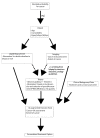Grading Evolution and Contemporary Prognostic Biomarkers of Clinically Significant Prostate Cancer
- PMID: 33562508
- PMCID: PMC7914622
- DOI: 10.3390/cancers13040628
Grading Evolution and Contemporary Prognostic Biomarkers of Clinically Significant Prostate Cancer
Abstract
Gleason grading remains the strongest prognostic parameter in localized prostate adenocarcinoma. We have here outlined the evolution and contemporary practices in pathological evaluation of prostate tissue samples for Gleason score and Grade group. The state of more observer-independent grading methods with the aid of artificial intelligence is also reviewed. Additionally, we conducted a systematic review of biomarkers that hold promise in adding independent prognostic or predictive value on top of clinical parameters, Grade group and PSA. We especially focused on hard end points during the follow-up, i.e., occurrence of metastasis, disease-specific mortality and overall mortality. In peripheral blood, biopsy-detected prostate cancer or in surgical specimens, we can conclude that there are more than sixty biomarkers that have been shown to have independent prognostic significance when adjusted to conventional risk assessment or grouping. Our search brought up some known putative markers and panels, as expected. Also, the synthesis in the systematic review indicated markers that ought to be further studied as part of prospective trials and in well characterized patient cohorts in order to increase the resolution of the current clinico-pathological prognostic factors.
Keywords: Gleason grading; biomarker; grade grouping; prostate cancer; survival.
Conflict of interest statement
The authors declare no conflict of interest. The funders had no role in the design of the study; in the collection, analyses, or interpretation of data; in the writing of the manuscript, or in the decision to publish the results.
Figures


References
-
- Adams J. The case of scirrhous of the prostate gland with corresponding affliction of the lymphatic glands in the lumbar region and in the pelvis. Lancet. 1853;1:393.
-
- Broders A.C. The grading of carcinoma. Minn. Med. 1925;8:1730–1925.
-
- Gleason D.F. Classification of prostatic carcinomas. Cancer Chemother. Rep. 1966;50:125–128. - PubMed
Publication types
Grants and funding
LinkOut - more resources
Full Text Sources
Other Literature Sources
Research Materials
Miscellaneous

